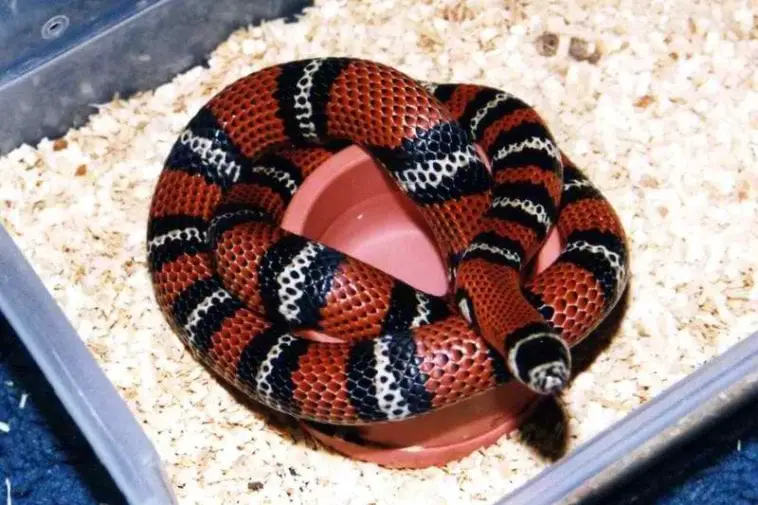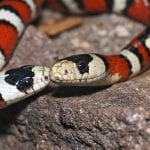Scientific Facts
| Common Name | Andean milk snake |
| Scientific Name | Lampropeltis Triangulum andesiana |
| Life Span | 12 to 20 years (in captivity) |
| Size | Up to 6 feet long |
| Habitat | Grasslands and forests |
| Country of Origin | United States, Canada, and Ecuador |
Physical Description
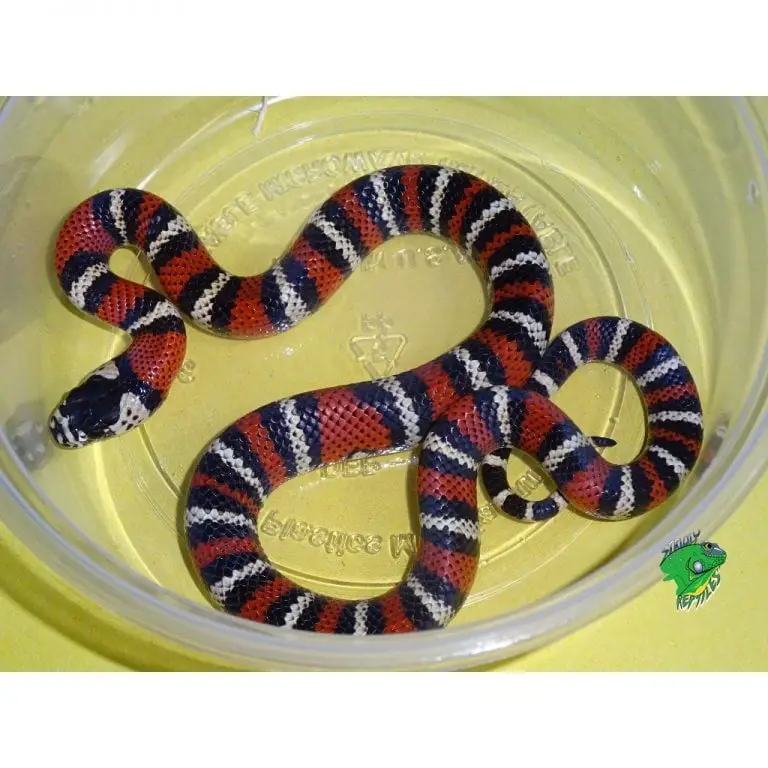
The Lampropeltis Triangulum andesiana or Andean milk snakes are the alpine milk snake subspecies. Compared to other non-venomous snakes that are mottled with brown and gray for camouflage, these snakes come in a great color combination, but adults are usually duller compared to juveniles. These snakes look almost dusky in yellow, black, and red. The red and white scales are tipped with black.
They also have white-colored scales on their snout that have black sutures and a big amount of white on their cheeks. They have 24-32 red-colored rings that might be divided with a shade of black within the mid-dorsal part while the rings might not entirely cross their venters.
Their bright colors are the same as those shades in the coral snakes. Andean milk snakes use the bright colors that fool their potential predators, making them think that they’re venomous and so dangerous to eat.
These colorful snakes come in the bands of black, red, and yellow. They also come with the black speckles on every scale. Andean milk snakes are among the biggest milk snake subspecies.
Range
These milk snakes exist all over the United States, from Canada up to Ecuador. These snakes are also found in the Andes mountains of Venezuela and Colombia.
Habitat
Andean milk snakes live in the high-altitude grasslands and forests of up to 9,000 feet tall.
Behavior
As the mountain dwellers, these milk snakes tolerate lower temperatures compared to other snakes. They love to spend their time in the under logs and burrows in which they’re safe from the potential predators and cold weather. Andean milk snakes usually leave their habitats in the afternoon and at night to hunt.
Life History
The female Andean milk snakes lay up to 4 egg clutches every year. Every clutch may contain 12 to 20 eggs. The hatchlings are 8 to 10 inches in length, but adults can grow longer and reach 38-70 inches. In captivity, these snakes can grow for 12 to 20 years.
Diet
Like other serpents, these milk snakes are carnivorous animals. The young snakes usually eat insects while the bigger milk snakes eat birds, mammals, amphibians, eggs, and other reptiles such as the venomous snakes. Like other snakes, the milk snakes must eat once each 1 to 2 weeks.
Breeding
Breeding these milk snakes in captivity is not different from what you need to do for other milk snakes. Wait for the end of October, and stop feeding your pet. Allow the snake to clear its gut, which normally takes 2 to 3 weeks. Slowly reduce the temperature in the enclosure to less than 50 degrees Fahrenheit and maintain this temperature for up to 3 months.
Always check your pet. Don’t forget to provide it with clean water and routinely check the animal for its overall condition throughout this brumation period. After this, bring back the temperature inside the enclosure to 78 to 80 degrees Fahrenheit. Feeding has to resume for around 3 weeks. Put a male and a female snake together for a limited time until copulation occurs.
If the copulation is successful, then you may use an egg-laying slot that should be partially full of damp sphagnum moss or vermiculite. Eggs must be removed right away after laying and put in wet vermiculite. The incubation period lasts from 59 to 68 days. The temperature must be 80 to 83 degrees Fahrenheit.
Housing
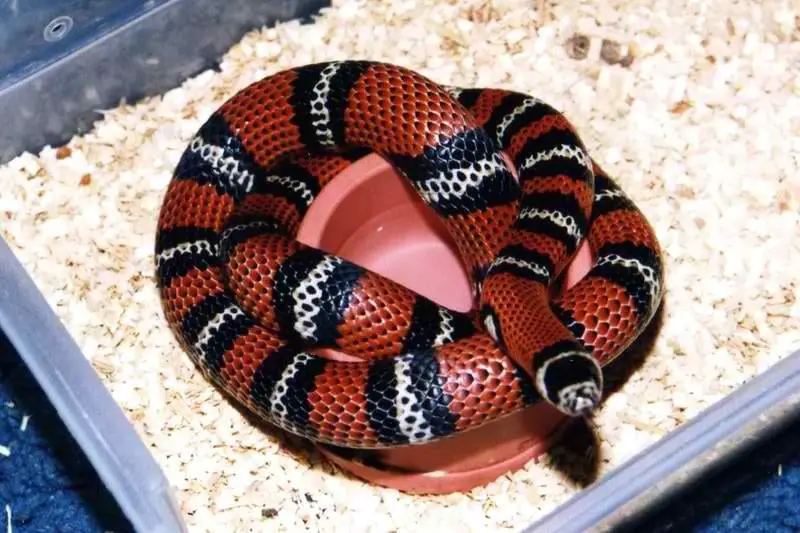
Milk snakes of all types require a strong and secure cage that will never give them a chance to escape. However, most keepers often settle for a wrong enclosure. In many cases, milk snakes assume a bigger enclosure would be good for their pets.
Remember, milk snakes of any kind don’t feel good when kept in a bigger enclosure. They tend to be so nervous when kept in big and open spaces. At the same time, the enclosure should be a bit spacey.
If the cage is too cramped, milk snakes may get stressed. The enclosure has to look cozy and feel snug, but never restrictive. Thankfully, choosing the right enclosure is not as difficult as it sounds.
For Andean milk snakes, you require an enclosure or vivarium that is 1 ½ time their bodies’ length. This way, these snakes will have ample space for crawling and exploration. While there is no typical sizing chart for enclosures, it is a golden rule that all pet owners should follow:
- A 20-gallon tank is good for 3-feet long snakes
- A 30-gallon tank is for 3 to 4-feet long snakes
- A 40-gallon tank is for snakes measuring more than 4 feet long
Material
A glass enclosure has secure and breathable lids that will allow you to display and show off your pet. The glass on top of the cage will present the vivid coloring of Andean milk snakes. However, a glass enclosure does not retain heat like what other materials can do. Maintaining the ideal enclosure temperature for various parts of the day could be daunting because glass gives off the heat so easily.
Plastic is a good alternative for glass. It is lightweight, effective, and affordable. However, this is often looked down upon by the experienced snake keepers and breeders. A plastic enclosure can be an excellent choice if you’re searching for a nice temporary enclosure for the hatchlings.
Wood is also a nice material for the enclosure. This material effectively insulates heat while its all-enclosed design is making the snake feel snug and secure. The only possible drawback of a wooden enclosure is that you cannot see your pet through this enclosure, like what you can do with the glass one.
Whatever material you choose, every kind of enclosure has become much easier to use. Most of the enclosures sold in the market these days have a gliding panel, which will give you easy access to the interiors of the cage for easy cleaning and worry-free maintenance.
Temperature
Various milk snake subspecies exist in diverse landscapes, which means their needs for temperature may significantly differ. For instance, the Andean milk snakes live within the mountainous terrain in the Andes. The temperature in this region is cold, although it is near to the equator. On the other hand, the Mexican milk snakes exist in semi-arid and hot deserts located in Mexico.
The best way to make sure the temperature in the enclosure is right for your pet will be to learn more regarding the animal’s natural habitat and adjust it accordingly. Milk snakes need a synthetic temperature gradient inside the enclosure, which lets them thermoregulate.
A warming basking spot in one portion of the cage can be made by using a 25-50 watt spot lamp. However, if you can sustain the temperature only by using a heating pad, then forget about the bulb.
Moreover, milk snakes, particularly the Andean milk snakes, are crepuscular. They hate bright lights. If you choose to use lighting, you may go for reptile lamps that produce blue, green, or red light to reduce the brightness when necessary. You can also use a timer. Connect it to the light to automatically switch it on and off, allowing your pet to rest at night.
The bulb must be hanged out of the enclosure. Don’t keep it in the terrarium because snakes may unintentionally burn themselves as they curl up beside the heat source.
Nighttime temperatures are maintainable by using heating pads or tapes with thermostats. For the heat map, it should cover 1/3 of the enclosure and must be quick to adjust. The benefit of a thermostat is it can automatically check the temperature within the cage. At the same time, it can switch the heat map on when necessary depending on the preset settings.
If you don’t want to spend much, then a heat tape will be enough. The caveat is you don’t need to manually check the temperature and adapt accordingly that could be awkward. Use a thermometer inside the enclosure and check the temperature.
Humidity
Again, the ideal humidity level for your Andean milk snake will vary on where the subspecies came from. Those snakes that live in the south portion of their range usually require more humidity compared to species that are living in the dry arid regions in the north. In line with this, most of the milk snakes stay well when the humidity level is between 40-70 percent. This will help prevent dry skin and respiratory issues. You can use a hygrometer so that you can be sure that the humidity is always in the appropriate range.
Substrates
Andean milk snakes are quite shy and will spend time mostly in burrowing. Therefore, they require a deep substrate within the enclosure. A dry substrate will prevent excessive moisture from accumulating inside the cage.
Beech woodchips are also a good option. The same is the case for aspen. High-quality aspen bark looks great. It is dust-free and can effectively absorb off-odors inside the enclosure. The substrate must be around 2 inches thick if you’re taking care of young and hatchlings. This substrate will let them explore and burrow.
Around 3 to 4 inches of a substrate must be right for the adult snakes, based on the milk snake. If your budget is not enough for the aspen bark, then you may go for cypress mulch. It will resist mold accumulation. It is also ideal for temperate zones that are more susceptible to extreme humidity.
Paper towels and newspapers are cost-effective options for a substrate. These materials are easy to clean and replaceable. Coconut husk mixture and gravel are also okay.
Some options seem to be great options that may trigger potential issues. These include sand and cedar chips. Cedar contains essential oils that can be harmful to milk snakes. Sand can be a good choice for milk snakes as they love to burrow, but it can also harm the skin of these snakes if trapped under the scales. Moreover, the snakes may accidentally swallow the sand.
Hiding Areas
Snakes do have the instinct to go and hide underneath the rocks, logs, and crevices. They also tend to show this behavior in captivity. Thus, make sure that there are 2 hide boxes within the enclosure, one in every temperature zone.
You may cut the holes in wooden or plastic boxes that are big enough for a snake to coil in. You can also line these hiding areas with wet sphagnum moss.
Hides crafted using ceramic or stone are a great option than plastic as they are heavier. Also, they are less likely to move or glide inside the cage as the snake goes in and out of the hides.
Avoid cardboard boxes like the shoe boxes as they may get soaked in the uric acid and fecal matter. They may become a huge breeding ground for the bacteria. As you can see, you have many options to choose from when it comes to the hiding areas and the one that is simple to clean.
Water Bowl
Keep the water bowl within the unheated portion of the cage as the snakes normally drink water when people are not around. Make sure that the bowl is big and will not tip over and tilt when the animal drinks water. Replace the water in the bowl once daily. At times, the snakes may pass uric acid or defecate in the water.
When you notice it, discard the old and refill the water bowl right away. Whenever possible, rinse and clean the water bowl once daily. Clean water should be provided to the animal during brumation.
Common Health Problems Associated with Milk Snakes
The milk snakes are usually resilient. They rarely suffer from severe health issues when you monitor them regularly and give a caring and hygienic environment. As part of the regular monitoring, here are some diseases which you have to know.
#1. Mites
While cats and canines get flea infestations, the snakes may gather the mites from the infected snakes and even from breeders where they came from. The mites in milk snakes look like dots on their scales, which can be in black, white, or red. When you try to check the scales of your pet, you will surely see these tiny insects moving around. Mites tend to concentrate around the eyes and on the nostrils of the snake.
#2. Internal Parasites
Captive Andean milk snakes don’t harbor parasites, unlike the wild specimens. But poor husbandry practices can lead to worm infestations. Trichomonas is among the most common parasites found in milk snakes. Good thing, it is easy to treat.
#3. Mouth Rot
It is a bacterial infection that affects the mouth of a milk snake if food particles were left behind or when an injury was left untreated. The bacteria associated with this infection create a thick, yellowish coating on its mouth that will eventually begin to eat and damage the tissue.
#4. Respiratory Infections
Andean milk snakes don’t acquire respiratory infections unless they’re seriously stressed. Stress can be due to some unsanitary conditions, random temperature fluctuations, and lack of food.
The most common symptoms of respiratory infections in Andean milk snakes include extended periods of dormancy, blowing bubbles, refusing to eat, and the excretion of mucus in the mouth. In some cases, respiratory infections lead to pneumonia and mouth rot. Fortunately, respiratory infections are treatable when detected as soon as possible.
Handling Tips
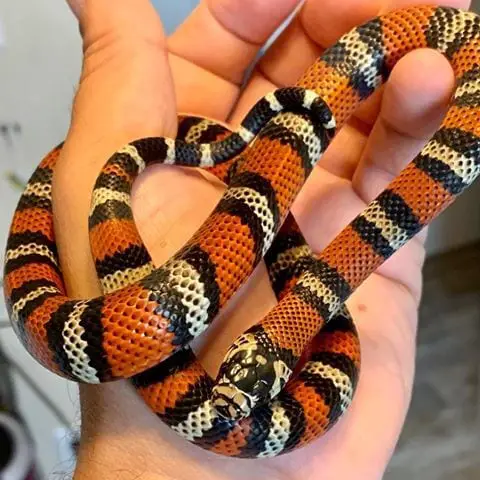
Andean milk snakes can be somewhat hard to handle, particularly for beginners. Most subspecies are not the ideal option for novices as they tend to be so nervous, which is more common among hatchlings and juveniles.
On the other hand, these milk snakes rarely show aggression when stressed or petrified. Instead, they may tend to release an annoying scent to show that it doesn’t like being handled.
Don’t be discouraged, though, because Andean milk snakes eventually become tame and responsive to handling if you do it properly and regularly. The trick is getting the animal used to being touched and helping it realize that you are not a threat. Here are some things that you can do for this purpose:
- Stand close to the enclosure as often as you can. This will help your pet in getting used to your care. At first, it may be defensive and even attempt to bite or strike. Stay calm. Just keep on doing it until the snake starts to feel comfortable when you’re around. It must take several days to a week.
- Just stay calm every time the snake is in your hands. When you hold it tight or make a sudden jerky move, the snake may interpret that as danger.
- Always keep the handling time quick and positive.
- Use two hands as you handle the snake. One hand must be under the belly of the snake while the other is on the top. Allow the snake to crawl around your hands without interruptions. Your hands can also prevent the snake from escaping.
- Don’t touch the snake after feeding it, when it’s hungry, or when you’re about to feed it.
Choosing the Best Andean Milk Snake
Since most milk snake varieties are okay with captivity, it’s quick to find one with qualities that suit your preferences. Right from the small and affordably priced Eastern milk snake to longer black milk snake, you have unlimited choices to choose from.
Buy your Andean milk snake from a reputable breeder. Check the hatchlings for the signs of injuries or diseases. There should be no blisters or bumps. The scales of the snake should be shiny, smooth, and even. Check the eyes and the head of the snake. Look at the pupils. They should be of the same color. Also, don’t forget to check them for mites.
Examine its vent for any symptoms of diarrhea. Watch out for crusting. It’s a telltale sign which indicates an underlying disease. Handle the snake. Do not be alarmed when the hatchlings or young snakes release a scent when you hold them. That is a natural reaction of milk snakes when they are anxious.
Availability – Where to Get One?
Andean milk snakes are widely available in both local and online pet stores today. You can also find them from the professional reptile breeders out there.
How to Care for an Andean Milk Snake?
Enclosures must be escape-proof with the heavy crock made of ceramic and filled with clean water. Also, your pets should have some hiding places like cage furniture. The milk snakes are cousins of the kingsnakes. Meaning, they could be cannibalistic and must be isolated from other animals.
Hobbyists keep these snakes in the plastic tubs. However, if you want your friends and relatives to see these beautiful snakes, then provide your pets with a 20-40 gallon terrarium. You can use different substrates like rodent bedding, aspen shavings, or newspapers. You need to keep the snake warm, dry, and clean.
Controlling the temperature is crucial for sustaining both proper digestion and good feeding response. The heat must be provided through the under tank heating pads. For Andean milk snakes, the temperature should be between 80-85 degrees Fahrenheit. You can drop the temperature at night to 60 degrees Fahrenheit.
When it comes to UV lighting, you can either use it for the enclosure of your pets or not. This will be up to you. Andean milk snakes feed on about anything such as the warm-blooded plants like birds and rodents and cold-blooded prey like lizards and frogs.
FAQs
What do Andean milk snakes eat?
Andean milk snakes eat small mice, birds, lizards, amphibians, and other snakes. In the wild, they tend to eat venomous snakes.
Are Andean milk snakes venomous?
Andean milk snakes look like the venomous coral snakes. These snakes, however, are non-venomous.
How long do Andean milk snakes live?
Andean milk snakes live for 12 to 20 years. Their lifespan can extend further with proper husbandry.
How do Andean milk snakes try to drive away their predators?
Andean milk snakes often vibrate their tails, just like what the rattlesnakes do. Also, they emit a musky scent to discourage predators.

